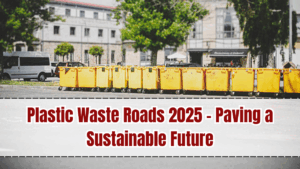Plastic pollution is one of the greatest environmental challenges of our time. Millions of tons of plastic waste are generated every year, much of which ends up in landfills, rivers, and oceans. In 2025, Plastic Waste Roads are emerging as an innovative solution that addresses both plastic waste management and infrastructure development. By blending shredded plastic waste with bitumen, engineers are constructing stronger, more durable, and eco-friendly roads. This approach is transforming the way countries manage waste while upgrading their infrastructure.

What are Plastic Waste Roads?
Plastic Waste Roads are constructed by mixing processed plastic waste with traditional road-building materials. The plastic, usually collected from household and industrial sources, is cleaned, shredded, and melted before being added to bitumen. This mixture creates roads that are more resilient to heat, water damage, and heavy traffic.
Key characteristics include:
-
Higher resistance to potholes and cracks.
-
Longer lifespan compared to conventional asphalt roads.
-
Reduced road maintenance costs.
-
Effective recycling of non-biodegradable waste.
Why They Matter in 2025
The adoption of Plastic Waste Roads 2025 has gained momentum for several reasons. Plastic waste is an environmental hazard, but converting it into infrastructure creates a win-win situation. Countries like India are leading the charge, constructing thousands of kilometers of roads using this method. These roads are not only stronger and more cost-effective but also help in reducing the volume of plastic waste that would otherwise pollute ecosystems. This innovation shows how sustainability and development can go hand in hand.
Benefits of Plastic Waste Roads
This sustainable infrastructure model offers multiple advantages:
-
Environmental Impact: Reduces plastic pollution and landfill usage.
-
Durability: Roads last longer and withstand extreme weather conditions.
-
Cost-Effectiveness: Lower construction and maintenance expenses.
-
Waste Management: Provides a large-scale solution for non-recyclable plastics.
-
Job Creation: New industries emerge around collection and processing of waste plastics.
Role of Technology
Technology plays a central role in making plastic roads possible. Specialized shredding machines process waste plastic into usable raw material. Heat-resistant binders ensure proper blending with bitumen, while AI-driven monitoring systems assess the performance of these roads over time. Additionally, GIS and smart mapping tools are being used to identify areas most suitable for plastic road projects, ensuring efficiency in planning and execution.
Government and Industry Initiatives
Governments across Asia and Africa are heavily promoting plastic roads as part of their waste management and infrastructure programs. In India, policies mandate the use of plastic waste in highway construction projects. Municipalities are collaborating with recycling units to supply raw material for road projects. At the same time, private construction companies and startups are investing in this model to align with global sustainability goals. These initiatives show how public and private sectors are working together to build greener infrastructure.
Future of Plastic Waste Roads
By 2030, plastic roads are expected to become a mainstream practice worldwide. Innovations may include smart plastic roads equipped with sensors to track traffic flow and road health. Countries may also integrate solar panels into road surfaces to produce renewable energy while recycling waste. As awareness about circular economies grows, plastic waste roads will play a vital role in achieving zero-waste goals globally.
Conclusion
Plastic Waste Roads 2025 demonstrate how environmental challenges can be turned into opportunities. By recycling plastic into durable infrastructure, nations are reducing pollution while creating stronger roads for citizens. This innovation proves that sustainability and development do not have to be opposites — they can reinforce each other. As adoption spreads worldwide, plastic roads could become one of the defining solutions of the fight against plastic waste.
FAQs
What are Plastic Waste Roads 2025?
They are roads built by blending shredded plastic waste with bitumen, creating stronger and more sustainable infrastructure.
How do they help the environment?
They reduce plastic pollution by recycling waste that would otherwise end up in landfills or oceans.
Are plastic roads more durable than normal roads?
Yes, they are more resistant to potholes, cracks, and weather-related damage, lasting longer than traditional roads.
Which countries are adopting plastic roads?
India is leading the way, with thousands of kilometers already built, followed by adoption in other Asian and African countries.
What is the future of plastic roads?
The future includes global adoption, integration with smart technologies, and a key role in circular economy initiatives.
Click here to know more.